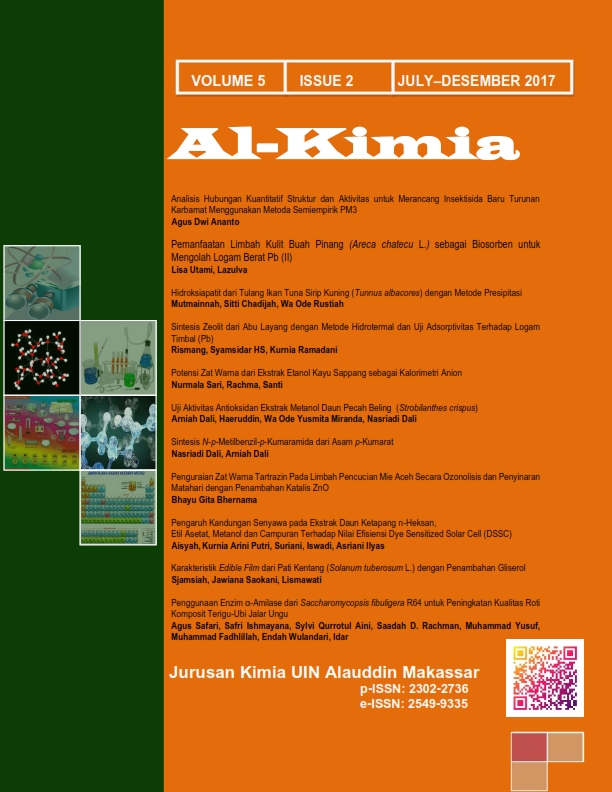Potensi Zat Warna dari Ekstrak Etanol Kayu Sappang Sebagai KalorimetriAnion
Abstract
Dye from Sappang Tree has been isolated using ethanol as a solvent. Braziline is one of the chemical compound found in the ethanol extract. The Compound can be used as anion calorimethric due to their active sites of hydroxyl and chromophore groups. Dyes from sappang tree has been tested on 10 g of several types of saturated anions (carbonate, sulfate, phosphate, cyanide, acetate, borax, nitrite, chloride, bromide, and iodide). The results of the tests show that the color of the dye from changes in carbonate, phosphate, cyanide, acetate, nitrite, and hydroxyl. Spectrophotometer UV/Vis is used to detect the limit of cyanide anion. Metanol and acetone show positive results on the dye in cyanide anion. Detection limit of braziline is 3x10-4 M. By addition of cyanide anion, the dye has detection limit at 1x10-4 M.
Downloads
References
Afkhami, A. & Nahid, S. (2007). A novel cyanide sensing phase based on immobilization of methyl violet on a triacetylcellulose membrane, Sensor and Actuator B, 122 (2) 437-441.
Alghiri, D. (2010), Sintesis turunan chalcone dari vanilin dan potensi penggunaannya sebagai indikator titrasi asam basa dan sensor anion, Tesis, Jurusan Kimia FMIPA UGM, Yogyakarta.
Indriani, H. (2003). Stabilitas pigmen alami kayu secang (caesalpinia sappan linn.) dalam model minuman ringan. Skripsi. Institut Pertanian, Bogor.
Marini, V., G., Torri, E., Zinmermann, L., M., & Machadoa, V., G. (2010). Anionic chromogenic chemosensor based on 4-(4-nitrobenzylideneamine)-2,6-diphenylphenol for selective detection of cyanide in acetonitrile-water mixture, ARKIVOC, 11, 146-162.
McDonagh, C., Burke, C.S. & Mac.Craith, B.D. (2008). Optical chemical sensors, Chem. Rev., 108(2), 400-422.
Reichardt, C. (1994). Solvatochromic dyes as solvent polarity indicators, Chem. Rev., 94 (8), 2319-2358.
Satheshkumar, A., Mossalamy, E.H., Manivannan, R., Parthiban, C., Al-Harbi, L. M., Kosa, S., … Elango, K.P. (2014) Anion induced azo-hydrazone tautomerism for the selective colorimetric sensing of fluoride ion, Spectrochim. Acta, Part A, 128, 798-805.
Timberlake, C.F. & Bridle P. (1983). Anthocyanins. di dalam J. Walford (ed). Developments in Food Colours. London, Applied Science Publishers LTD.
Xu, Z., Chen, X., Kim, H. N., & Yoon, J. (2010). Sensor for the optical detection of cyanide ion, Chem. Soc. Rev., 39(1), 127-137.
Zhang, C., & Suslick, K., S. (2005). A colorimetric sensor array for organics in water, J. Am. Chem. Soc., 127(33), 11548-11549.
Copyright (c) 2017 Nurmala Sari

This work is licensed under a Creative Commons Attribution-NonCommercial-ShareAlike 4.0 International License.
Authors who publish with this journal agree to the following terms:
1) Authors retain copyright and grant the journal right of first publication with the work simultaneously licensed under a Creative Commons Attribution License that allows others to share the work with an acknowledgement of the work's authorship and initial publication in this journal.
2) Authors are able to enter into separate, additional contractual arrangements for the non-exclusive distribution of the journal's published version of the work (e.g., post it to an institutional repository or publish it in a book), with an acknowledgement of its initial publication in this journal.
3)Authors are permitted and encouraged to post their work online (e.g., in institutional repositories or on their website) prior to and during the submission process, as it can lead to productive exchanges, as well as earlier and greater citation of published work (See The Effect of Open Access).


